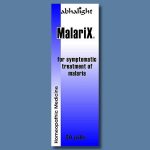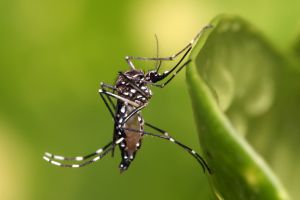Disclaimer
While homeopathic medicines have been found effective in the prevention and treatment of malaria, it may not be effective for everyone, every time. If you do get malaria, and find no immediate benefit from this remedy within 12-18 hours, immediately go to a medical facility for treatment. In any case, always use a mosquito net at night and if possible, use insect repellent.
Malarix Info
 Malarix is a homeopathically prepared complex formula that has been successfully used to prevent and treat malaria in Kenya & Africa for the last 15 years. Thousands of Kenyans use it regularly for prevention. And thousands of others have used it successfully to treat malaria when it has befallen them. Under ALF’s Malaria-Free charity programme, over 1500 Kenyan families are receiving free malaria prevention and are now malaria-free. Malarix comes in the form of small, round homeopathic pills. Read further on how you can use it.
Malarix is a homeopathically prepared complex formula that has been successfully used to prevent and treat malaria in Kenya & Africa for the last 15 years. Thousands of Kenyans use it regularly for prevention. And thousands of others have used it successfully to treat malaria when it has befallen them. Under ALF’s Malaria-Free charity programme, over 1500 Kenyan families are receiving free malaria prevention and are now malaria-free. Malarix comes in the form of small, round homeopathic pills. Read further on how you can use it.
Using Malarix as a Preventative
Malarix has been clinically found to be effective in prevention, or long-lasting relief from chronic malaria. Here’s how to use it.
Travellers
At the beginning of your journey- in the first days or just before – begin the prevention programme. Take 1 dose a day (see below 2 methods) for the first 3 days. After that, take 1 dose a week. continue up till 2 weeks after you return.
Residents of High Risk Areas
The first time you take it, take 1 dose a day (see below 2 methods) for the first 3 days. After that, take 1 dose a week and continue that throughout the year.
Thank you for supporting the work of Abha Light through your purchase. All profits from your purchase goes to support our free anti-malaria distribution projects and work.
How to use homeopathic medicines
Take homeopathic medicines on an empty stomach. Avoid taking homeopathic medicines when you just ate, drank or brushed your teeth. Store homeopathic medicines away from direct sunlight, heat, perfume, smoke or pollutants. Like all medicines, keep out of the reach of children. If symptoms persist, see your health care provider immediately.
2 methods of using homeopathic medicines
Pills, easy method: 1 pill is a dose. Put 1 pill into your mouth and let it dissolve under your tongue.
Water Remedy, the most economic: This method is great for children, babies, too. Very useful for dosing a large number of people at a time. Put 1 pill into a fresh 1/2 litre bottled plain spring water. (or 2 pills into a litre) Let the pill dissolve for 5 minutes. Bang the bottle firmly against your palm 10 times. One teaspoon (or a small sip) is a dose. Bang it again before each time you take a dose.
Water Method for Mass Treatment: Using the water remedy method, you can dose a large number of people at once. (a whole village!) However the water remedy may lose its potency (active power) within 2-3 days.
So each week use fresh water and new pill. DON’T use that water bottle for any other purpose. Homeopathy is a funny thing. The remedy could still be active in that used bottle and you may be unknowingly over-dosing yourself – causing a homeopathic aggravation that increases symptoms temporarily or looks like malaria. Should that happen, by mistake, drink a cup of coffee or sniff some camphor (tiger-balm) and simply wait it out for 1 day or so. Such type of homeopathic aggravation-effects are generally short-lived.
In case of malaria
Use the water method described above by putting the remedy into water. At the beginning, take sip-doses every 1/2 hour, then as you improve, slowly stretch it out to every 1 hour, again then every 2-4 hours as you continue to improve. If you finish the bottle, refresh it with water and new pills. Continue dosing yourself even if you’re feeling good for about a week. (otherwise you may relapse)Our experience has been that people feel very OK after, say, 1-2 days. They stop the medicine and start working (& stressing themselves) again. That causes them to relapse. So DON’T do that. Take the medicine for 5-7 days, even if its dosing just 3 times a day. AND take it easy, bedrest, don’t go stressing yourself with heavy travel or workload.
If you do get malaria, and find no immediate benefit from this remedy within 12-18 hours, immediately go to a medical facility for treatment.
Signs of malaria
 The incubation period for malaria is usually between 9 and 16 days, though longer in rare cases. The symptoms for all of the subgroups are broadly similar and relate to the parasite’s cycle of reproduction and subsequent destruction of the body’s red blood cells. Initially, malaria is very difficult to distinguish from many other febrile illnesses, especially those found in the tropics. Classically, victims go through three stages: a cold stage characterized by shivering and shaking, a hot stage in which you develop a high temperature (sometimes above 41C), hot flushes and rapid heartbeat, and a third, sweating stage during which your temperature falls.
The incubation period for malaria is usually between 9 and 16 days, though longer in rare cases. The symptoms for all of the subgroups are broadly similar and relate to the parasite’s cycle of reproduction and subsequent destruction of the body’s red blood cells. Initially, malaria is very difficult to distinguish from many other febrile illnesses, especially those found in the tropics. Classically, victims go through three stages: a cold stage characterized by shivering and shaking, a hot stage in which you develop a high temperature (sometimes above 41C), hot flushes and rapid heartbeat, and a third, sweating stage during which your temperature falls.
Typically the fever recurs cyclically, every 1-3 days depending on the type of malaria. Common accompanying symptoms include a cough, joint pains, loss of appetite and vomiting, which coupled with the high fever can cause significant dehydration. As the disease progresses, anaemia and jaundice may occur as a result of the destruction of large numbers of red cells and the spleen (functionally a kind of filter for the blood) becomes enlarged early in the disease. You’ll feel it as a tender mass in the left side of your upper abdomen.) By far the most dangerous form of malaria, falciparum, can cause considerable damage to the body in a number of ways, and death in about 2 percent of cases usually as a result of delayed treatment. Cerebral malaria is the most dangerous complication, and if untreated can be fatal.
